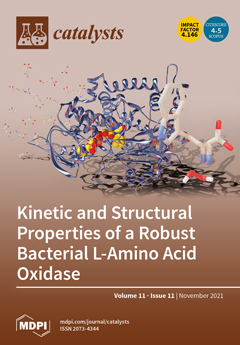There is a considerable practical interest in discovering new ways to obtain organomolybdenum heterogeneous catalysts for olefin epoxidation that are easier to recover and reuse and display enhanced productivity. In this study, the complex salt (H
2pytz)[MoO
2Cl
2(pytz)] (
1) (Hpytz = 5-(2-pyridyl)tetrazole) has been prepared, structurally characterized, and employed as a precursor for the hydrolysis-based synthesis of a microcrystalline molybdenum oxide/organic hybrid material formulated as [MoO
3(Hpytz)] (
2). In addition to single-crystal X-ray diffraction (for
1), compounds
1 and
2 were characterized by FT-IR and Raman spectroscopies, solid-state
13C{
1H} cross-polarization (CP) magic-angle spinning (MAS) NMR, and scanning electron microscopy (SEM). Compounds
1 and
2 were evaluated as olefin epoxidation catalysts using the model reaction of
cis-cyclooctene (Cy8) with
tert-butyl hydroperoxide (TBHP), at 70 °C, which gave 100% epoxide selectivity up to 100% conversion. While
1 behaved as a homogeneous catalyst, hybrid
2 behaved as a heterogeneous catalyst and could be recovered for recycling without showing structural degradation or loss of catalytic performance over consecutive reaction cycles. The substrate scope was broadened to monoterpene
DL-limonene (Lim) and biobased unsaturated fatty acid methyl esters, methyl oleate (MeOle), and methyl linoleate (MeLin), which gave predominantly epoxide products.
Full article





